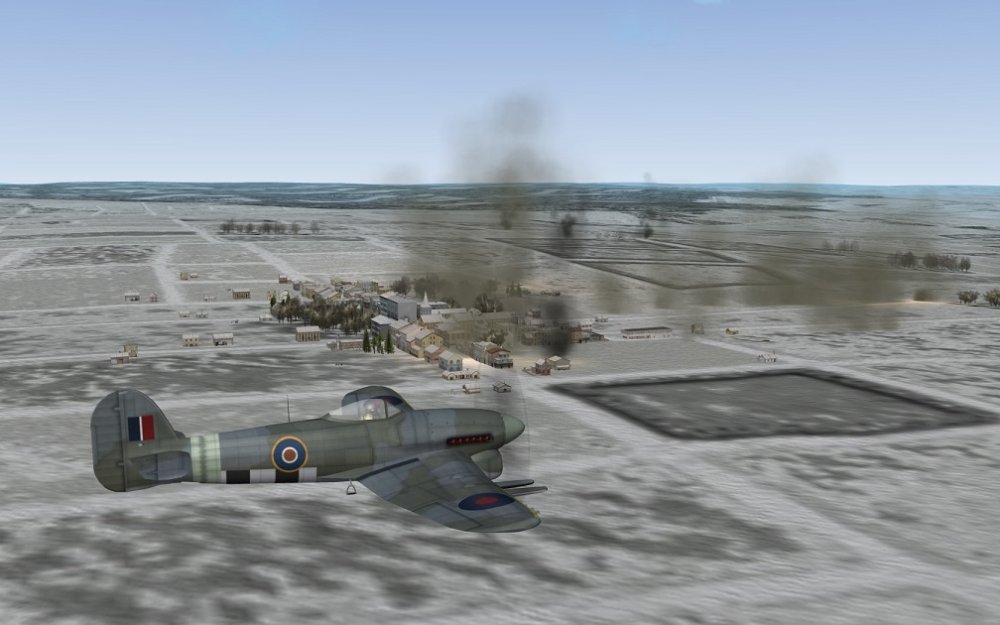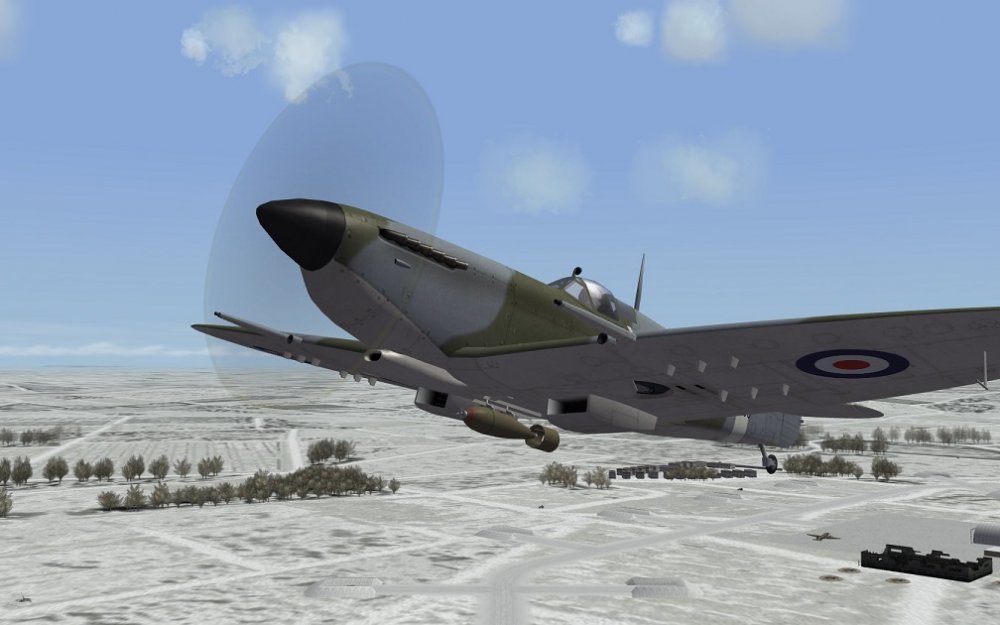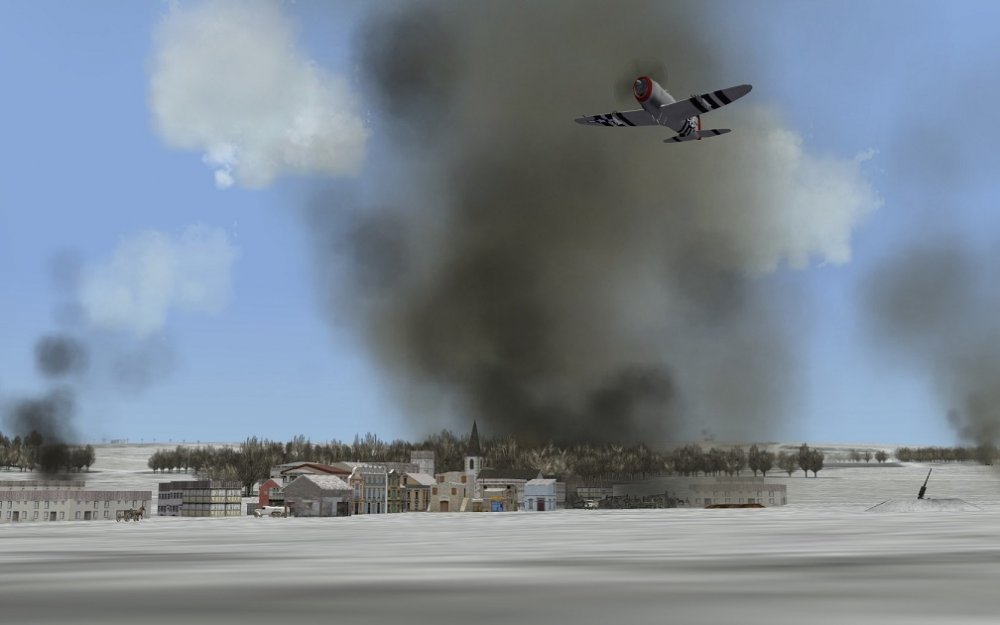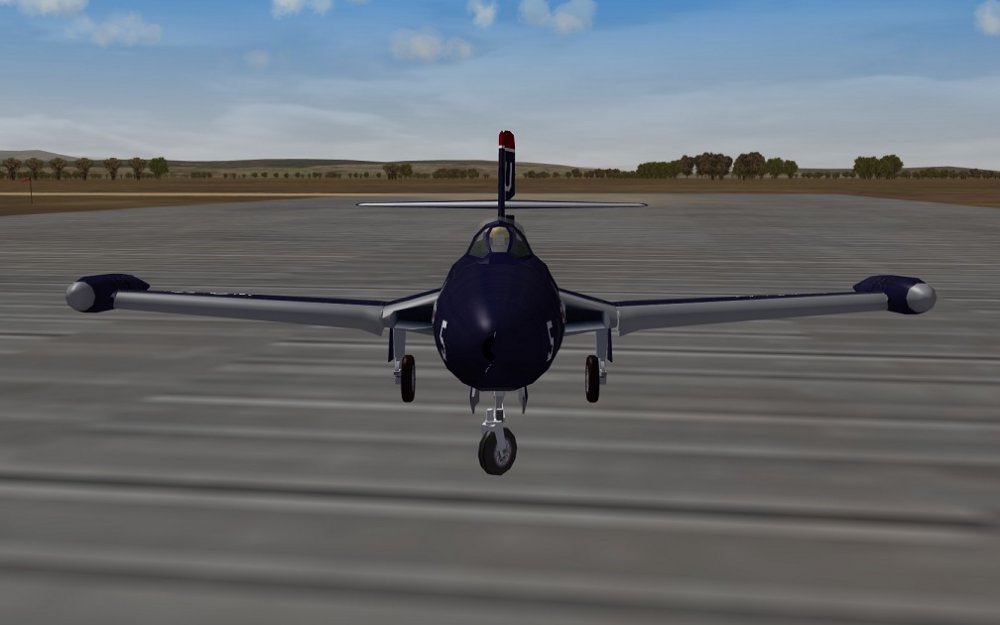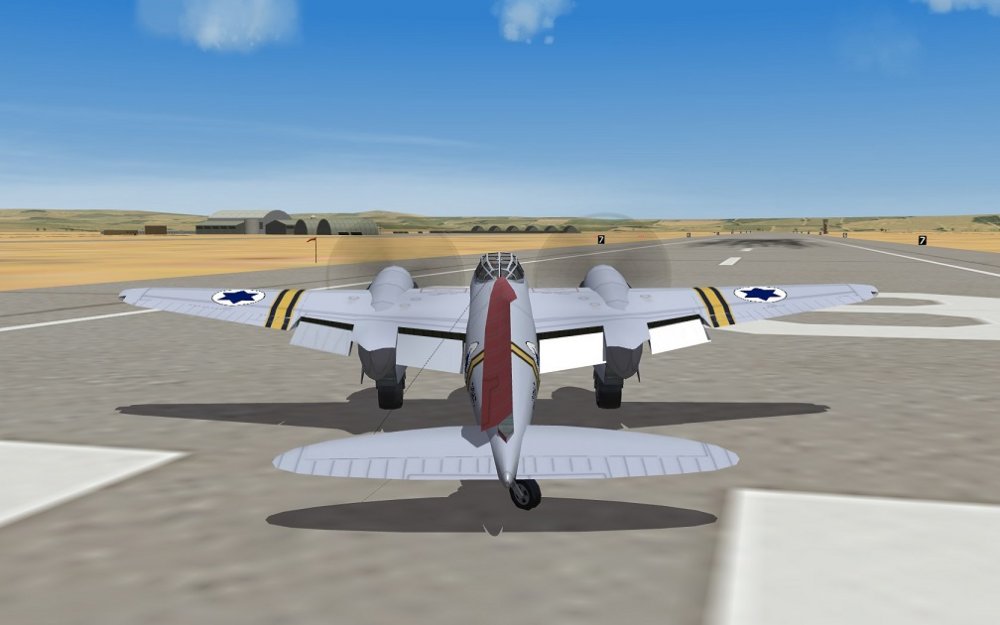-
Posts
1,290 -
Joined
-
Last visited
-
Days Won
11
Content Type
Profiles
Forums
Gallery
Downloads
Store
Everything posted by baffmeister
-
This FM is for Veltro2K's Typhoon 1B bubble top, available here: https://combatace.com/files/file/14738-hawker-typhoon-mk-ib-bubble-top/ Besides the FM/Data.ini, you will also find a new cockpit.ini with a position adjustment and a new loadout.ini. I've also included a couple of WW2 bombs as well as a bomb pylon that's being used to address a model issue, more info below. NOTES: The Typhoon had a very thick wing, with a thickness/chord ratio similar to the Hurricane. To get started on this FM I imported some of the data from my Hurricane FM and it seemed to work quite well so I ended up just making a number of edits to get the desired behavior. Actual high quality data available is quite sparse so it's based on mostly anecdotal information. Turn rates are better than the P-47D-40 but similar to the Tempest and FW-190 so you will want to keep the speed up. When doing a Soviet style turn time test I got about 24sec. Some adjustments have been made to the Sabre engines WEP table so the Tempest will be getting that update as well. The maximum roll rate for the Typhoon was rather poor at about 55deg/sec at 250mph. Quite a large "spread" in the various speed charts I was looking at. With this one you can expect about 345mph at sea level and about 395mph at 18000ft. In general, its about 20-30mph slower than the Tempest at all altitudes. BOMBS: Two bombs included, one 500lb-MC and one 1000lb-MC. These came in various Mark numbers but I don't see much point in having more than one of each. In general, the MC [medium capacity] series had an explosive/total weight ratio of about 50%, with different fin, fusing and attachment set-ups for the various marks. From some relatively light weight research, it seems the MC series was developed in 1942 and became available in 1943. No idea what the end service date is. The Typhoon data.ini has a length restriction for the bombs to make the later TW UK bombs unavailable. BOMB PYLON: To address a strange weight distribution issue when carrying bombs, I've put together a work-around. The bomb pylons are installed as no weight, no jettison, specific station Drop Tanks! When doing a strike or anti-ship mission the new loadout.ini will include the bomb pylons as well as the new 500lb-MC bomb. This setup works fine but just remember, if you ever want to change the loadout manually, don't forget to include the pylons when carrying bombs. If desired, engine exhaust and prop inertia effects can be activated by removing the double slashes from these entries: ExhaustEmitterName=//CleanExhaustEmitter and MomentOfInertia=//8.0 Here's the data.ini and assorted bits: Typhoon1B-0.95.zip
- 1 reply
-
- 3
-

-

-
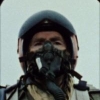
WW2 Screenshots Thread
baffmeister replied to Wrench's topic in Thirdwire: Strike Fighters 2 Series - Screen Shots
More "Heavy Metal" although it's 1 ton lighter than a P-47D-40, with both at typical clean combat weight. -
Could someone tell me what the CEP= entry in the bomb data ini's represents? I noticed all the TW dumb bombs I've looked at have CEP=20 for that entry while all the "aftermarket" dumb bombs have CEP=0. The very last entry: [WeaponData001] TypeName=Mk81 FullName=Mk.81 250-lb Bomb ModelName=mk81 Mass=113.400002 Diameter=0.230000 Length=1.880000 SubsonicDragCoeff=0.092000 SupersonicDragCoeff=0.357000 AttachmentType=NATO SpecificStationCode= NationName=USAF StartYear=1957 EndYear=0 Availability=3 BaseQuantity=24 Exported=TRUE ExportStartYear=1957 ExportEndYear=0 ExportAvailability=3 WeaponDataType=0 RailLaunched=FALSE Retarded=FALSE FinStabilized=TRUE SpinStabilized=FALSE EffectClassName=SmallBombEffects DragAreaMultiplier=1.000000 WarheadType=0 Explosives=44.000000 FusingDistance=0.000000 ClusterBomblets=0 ClusterDispersion=0.000000 GuidanceType=0 Accuracy=0 MaxTurnRate=0.000000 MaxLaunchG=0.000000 LockonChance=0 LaunchReliability=0 ArmingTime=0.000000 SeekerFOV=0.000000 SeekerGimbleLimit=0.000000 SeekerTrackRate=0.000000 SeekerRange=0.000000 LiftDragRatio=4.000000 ReleaseAnimationID=-1 EODisplayFlags=0 CEP=20.000000....................................................THIS?
-
After doing a bit of research I'm just going to leave the "RAF" bomb series alone for now. They are probably being used quite a bit for the WW2 bombers and I don't want to mess with them at this point. I did have a look at the lods and they don't seem to resemble the early WW2 RAF bombs all that well except for the ring around the tail fins. Some of them look more like the later MC [medium capacity] types that entered service in 1943. I will include a couple of bombs with the Typhoon FM. The lod for the RAF500[kg!] makes a good 1000lb-MC so will include that. I also found a nice 500lb-MC in my regular SF-2 install but don't know where it came from. Both will get checked over and re-packaged for "Bulge" use. I also checked over ThirdWires UK250lb, UK500lb and UK1000lb. The 500 and 1000 look like newer bombs but the UK250lb looks exactly like the 250lb GP used in WW2 so I might re-package that one at some point. Here's a pic of the ThirdWire 250lb GP. In game it shows up as "250-lb Bomb" .
-
I'm not aware of any limitations regarding the resolution of the data but how much is too much? Here's a stall table from one of the old AvHistory WW2 FM's, circa 2009. I think these were made for SF1 at the final patch level. StallDragTableNumData=255 StallDragTableDeltaX=1.41732283464567 StallDragTableStartX=-180 // StallDragTableData=1,1.192,1.389,1.597,1.821,2.065,2.336,2.638,2.976,3.357,3.784,4.264,4.789,5.345,5.915,6.484,7.036,7.555,8.026,8.435,8.783,9.073,9.307,9.487,9.616,9.696,9.73,9.72,9.669,9.579,9.452,9.291,9.099,8.878,8.63,8.357,8.064,7.75,7.42,7.076,6.72,6.354,5.982,5.604,5.225,4.846,4.47,4.1,3.737,3.384,3.044,2.72,2.413,2.127,1.864,1.627,1.417,1.238,1.093,0.983,0.912,0.881,0.894,0.953,1.06,1.214,1.413,1.651,1.924,2.229,2.562,2.918,3.293,3.683,4.085,4.494,4.905,5.316,5.722,6.119,6.503,6.869,7.214,7.534,7.825,8.082,8.303,8.488,8.637,8.751,8.829,8.871,8.878,8.85,8.786,8.687,8.554,8.385,8.182,7.944,7.672,7.369,7.037,6.678,6.295,5.89,5.467,5.026,4.571,4.105,3.635,3.167,2.666,2.18,0.869,1.015,0.979,1.007,1.001,0.996,0.998,1,1,1,1,1,1,1,1,1,1,1,0.999,0.999,1.001,1.001,0.995,1.004,0.973,1.244,1.665,2.083,2.498,2.914,3.331,3.75,4.197,4.666,5.148,5.631,6.104,6.557,6.979,7.359,7.687,7.951,8.143,8.263,8.32,8.319,8.268,8.173,8.042,7.881,7.693,7.482,7.249,6.996,6.727,6.442,6.145,5.837,5.522,5.2,4.875,4.549,4.223,3.901,3.584,3.274,2.975,2.688,2.415,2.159,1.922,1.706,1.514,1.348,1.209,1.101,1.025,0.984,0.978,1.006,1.066,1.156,1.276,1.423,1.597,1.795,2.017,2.261,2.524,2.807,3.106,3.422,3.752,4.094,4.448,4.81,5.178,5.549,5.92,6.289,6.654,7.011,7.359,7.694,8.013,8.315,8.597,8.855,9.088,9.292,9.466,9.606,9.71,9.775,9.799,9.778,9.712,9.595,9.428,9.205,8.926,8.587,8.185,7.719,7.198,6.637,6.055,5.467,4.892,4.346,3.847,3.402,3.008,2.659,2.349,2.072,1.824,1.599,1.39,1.192,1 StallXacShiftTableNumData=255 StallXacShiftTableDeltaX=1.41732283464567 StallXacShiftTableStartX=-180 StallXacShiftTableData=-2.539,-2.517,-2.495,-2.474,-2.452,-2.43,-2.408,-2.386,-2.364,-2.342,-2.32,-2.298,-2.276,-2.254,-2.232,-2.21,-2.188,-2.166,-2.144,-2.122,-2.1,-2.078,-2.056,-2.034,-2.012,-1.99,-1.968,-1.946,-1.924,-1.902,-1.88,-1.858,-1.836,-1.815,-1.793,-1.771,-1.749,-1.727,-1.705,-1.683,-1.661,-1.639,-1.617,-1.595,-1.573,-1.551,-1.529,-1.507,-1.485,-1.463,-1.441,-1.419,-1.397,-1.375,-1.353,-1.331,-1.309,-1.287,-1.265,-1.243,-1.221,-1.199,-1.177,-1.155,-1.134,-1.112,-1.09,-1.068,-1.046,-1.024,-1.002,-0.98,-0.958,-0.936,-0.914,-0.892,-0.87,-0.848,-0.826,-0.804,-0.782,-0.76,-0.738,-0.716,-0.694,-0.672,-0.65,-0.628,-0.606,-0.584,-0.562,-0.54,-0.518,-0.496,-0.474,-0.453,-0.431,-0.409,-0.387,-0.365,-0.343,-0.321,-0.299,-0.277,-0.255,-0.233,-0.211,-0.189,-0.167,-0.145,-0.123,-0.101,-0.078,-0.055,0.006,-0.001,0.001,0,0,0,0,0,0,0,0,0,0,0,0,0,0,0,0,0,0,0,0,0,0.001,-0.013,-0.035,-0.057,-0.079,-0.101,-0.123,-0.145,-0.167,-0.189,-0.211,-0.233,-0.255,-0.277,-0.299,-0.321,-0.343,-0.365,-0.387,-0.409,-0.431,-0.453,-0.475,-0.496,-0.518,-0.54,-0.562,-0.584,-0.606,-0.628,-0.65,-0.672,-0.694,-0.716,-0.738,-0.76,-0.782,-0.804,-0.826,-0.848,-0.87,-0.892,-0.914,-0.936,-0.958,-0.98,-1.002,-1.024,-1.046,-1.068,-1.09,-1.112,-1.134,-1.155,-1.177,-1.199,-1.221,-1.243,-1.265,-1.287,-1.309,-1.331,-1.353,-1.375,-1.397,-1.419,-1.441,-1.463,-1.485,-1.507,-1.529,-1.551,-1.573,-1.595,-1.617,-1.639,-1.661,-1.683,-1.705,-1.727,-1.749,-1.771,-1.793,-1.815,-1.836,-1.858,-1.88,-1.902,-1.924,-1.946,-1.968,-1.99,-2.012,-2.034,-2.056,-2.078,-2.1,-2.122,-2.144,-2.166,-2.188,-2.21,-2.232,-2.254,-2.276,-2.298,-2.32,-2.342,-2.364,-2.386,-2.408,-2.43,-2.452,-2.474,-2.495,-2.517,-2.539 I have to wonder what affect a large engagement of WW2 planes with data inis like this would have on game play.
-
I've been finding some issues with the RAF bomb series. In my WW2 weapons folder I have folders called RAF50, RAF100, RAF250, RAF500 and RAF1000. Some have excessive weights and some have mixed up full names. The RAF series have their own lods. I also have some other bombs called UK250lb, UK500lb and UK1000lb. This series doesn't have lods in the folder and appears to use the stock TW UK bomb data. The weights etc. look fine but the dimensions are much different. I'm in the process of putting together a Typhoon FM and will be adjusting the Tempest load out as well so was wondering if someone could check the RAF series bombs in their WW2 install and see if they have the weight and naming errors as well. Not sure where I got either of these bomb series from but they may not be up to date. I could just fix the RAF series but that requires some research so would be interested in any suggestions from the weapon experts regarding the most realistic bombs to use for WW2 RAF use.
-
I think there have only been a handful of SF players over the years that could actually build what might be considered a HiFi flight model and even they would be limited somewhat by the games flight engine. I'm definitely not an FM guru and what I do is mainly just some basic lift/drag calculations while relying on assorted ThirdWire tables to at least supply some normal behavior. Having said that, I do spend a lot of time trying to track down real world information to build and test the FM's. I don't know of a way to output telemetry from a test flight. If you have a flight manual for the the aircraft, it's relatively easy to test the plane in game to see if it's close to some key numbers. Knowing the proper climb profile from the flight manual, you can check climb time to altitude. With hud in debug, you can check available "G" at various speeds. If you have a sustained "G" chart, you can check that to see if the FM is close to the real plane. Some of the older flight manuals are surprisingly light on information but even checking the take off distance and speed at a specific weight can be a good cross check for an FM. It sounds like you might be interested in a computer program based approach to flight models. I have heard of some people using excel type programs for calculating some coefficients but I'm no help there. There are some software gadgets that can make some basic lift/drag calculations. I used one tool called foilsim to try and generate CDL tables for cambered airfoils but the results always seemed a bit iffy. I'm trying a different math based approach now that seems better but still requires certain "assumptions" on my part that may or may not be correct. I used the new approach on the P-47 and it seemed to work reasonably well. I think an actual HiFi FM should demonstrate aircraft specific handling qualities but that's a whole different realm compared to just hitting the important numbers. ThirdWires FM's are probably quite good at that in a general way but seem to lack the real world behavior when at the limits. It is possible to "tinker" with the headline numbers to generate certain behavior but that's a long way from getting type specific behavior over the entire flight regime. Maybe DCS is getting close to that but I think only an actual pilot who has flown the type would know for sure. Not much help but maybe you could explain your intentions in a bit more detail? Someone else might know of some programs that would be useful when building FM's.
-

P-47D-40 Flight Model
baffmeister replied to baffmeister's topic in Thirdwire: Strike Fighters 2 Series - World War II Forum
I should have mentioned, no belly landing skids on the "Bulge" FM's yet. Will add some to the final versions. -

P-47D-40 Flight Model
baffmeister replied to baffmeister's topic in Thirdwire: Strike Fighters 2 Series - World War II Forum
I found those animations at the last minute. After getting my wing shot off I noticed what looked like a dive flap hanging in mid air. Checked in Mues lod viewer and found the part then checked all the animation ID's. Bonus! Some other stuff I should have mentioned. Due to some crash issues with other aircraft I didn't mess too much with the AI. The original AI seemed to work quite well for this plane and probably helps to keep the speed up. The higher speeds and heavier weights for the late war fighters will probably require some AI adjustments for the previously released Battle of the Bulge FM's. Another "tricky" issue is the strafe AI. With wing mounted guns the AI fighters will miss ground targets with the bullets hitting on either side of the target. With the guns angled in to converge at about 300 meters it's possible to get hits but the planes must get quite close to the target exposing them to more ground fire. The rocket AI I'm using for the P-47 rocket tubes also exposes the plane to a lot of ground fire. I might be able to get the rocket AI to work from longer ranges but I don't think the strafe AI can be adjusted to minimize the AAA threat. -
This FM is for the Cocas/Wrench package available here: https://combatace.com/files/file/16542-sf2-ww2-eto-p-47d-40-late/ This was quite an interesting FM to attempt. I didn't even know the late model P-47's had dive recovery flaps until I downloaded the package. The P-47 had good horsepower, especially with WEP, but it was also heavy with a high wing loading. The Soviet turn time tests put it in the 26-28 sec range. This FM seems to be at the low end of the range. When dog fighting it seems best to keep the speed up above 200kts and avoid turning contests. Any break in the action presents a good opportunity to grab some altitude which will offer some potential energy prior to the next engagement. If you dive down on targets at high speed the plane maneuvers quite well and you may have the option of a turn fight for a limited time. Quite a few changes to power ratings during the P-47's WW2 service. For Battle of the Bulge FM's I'm looking for the best power output when using 100-130 grade fuel as the higher octane 100-150 was restricted to aircraft based in England until early 1945. There was a kit developed in early 1944 that boosted the WEP rating with 100-130 grade from about 2300hp to 2535hp, both ratings using water injection. I got confirmation of this power rating from an RAF Thunderbolt II flight manual. The kit was meant for aircraft operating outside of England so was probably meant mainly for MTO and PTO operations. P-47's in England got a different kit that I think was meant for the transition to 100-150 grade fuel. Interestingly, from the speed charts I've been looking at, the earlier P-47's had higher speeds in the 30000ft range than the later versions. The later versions were faster up to about 25000ft so there may have been some changes to the turbocharger system as the P-47's were assigned more and more low level missions. With this FM you can expect max speeds of about 345mph at sea level and 435mph TAS at 25000ft. NOTES: DIVE RECOVERY FLAPS: Surprise! These were actually built into the model using an animation ID so the animation has been activated. On the real plane they were designed to shift the wings center of pressure forward to aid recovery from high speed dives. I tried to add some aero coefficients to get them to work like the real ones but it didn't work so went with the same approach as the original FM. They just work like airbrakes but are handy if you ever encounter my "Generic Mach Tuck Effect". INTERCOOLER DOORS: Another surprise animation ID, also activated. Not sure yet of the typical positions so I just set them up the same way Wrench did the cowl flaps. WEP TIME: There was a 30gal alcohol/water tank that gave about 14min and 30sec of WEP. The Thunderbolt II manual said this was limited to 5 Min at a time but, like the BF-109G-10, you get the full duration. ROLL RATES: From a couple of sources, max roll rate was about 90deg/sec at about 255 MPH. Still have to tune the low and high speed roll rates. ISSUES: Some of the cowl flaps are visible when viewed from the front but not from the back. A more realistic looking prop hub would be nice! Also, maybe a couple of distance lods? OTHER STUFF: I've been getting a lot of frame rate issues in my WW2 install, some of which is caused by effects. To help the situation the exhaust effect will be default off from now on. If desired, it can be activated by removing the double slash from the ExhaustEmitterName=//, in the engine section. My main intention with these WW2 FM's is to build an EAW style flight sim. After putting up with the MomentOfInertia effects for quite awhile and using the trim work around I've had enough so will go with "default off" for that effect. I will include at least a token number for the inertia effect and will make sure it works in the right direction. Activation is the same as for the exhaust emitter. Flight simmers looking for torque, slip stream and P-factor type effects should buy a different game! I have seen some definite errors in the ammo weights showing up in the load out screen. Occasionally, the weight is double what it should be. On the plus side, the extra weight doesn't show up in game when using the hud de-bug mode so seems to be just a harmless glitch. Here's the FM: P-47D40_DATA0.95.zip
-

WW2 Screenshots Thread
baffmeister replied to Wrench's topic in Thirdwire: Strike Fighters 2 Series - Screen Shots
-
A couple more "Battle of the Bulge" era FM's attached. I did some speed checks on the stock ThirdWire FM's and the speeds were too low for a Merlin 66 powered 100 octane version so I made a few changes. The sea level horsepower numbers looked good so the tail wheel drag numbers were adjusted similar to what I used for the Spit1 Battle of Britain FM's and the CD0 values were adjusted slightly to get the proper sea level speeds. Some of the speeds at altitude were still too low so I added some ram air boost to extend the full throttle heights an additional 2000ft for low and high blower and that gave some good numbers. With WEP, you can expect 335-340mph IAS/TAS at sea level and about 405mph TAS in the 19000-21000ft range. The speeds I checked at other altitudes up to 32000ft are all within +/- 5mph of the chart I was using so the engine table is a done deal. There may be some AI crash issues with the later WW2 FM's I've been making so some changes to the AI behavior may be required. For the Spit9's, I added an additional 5deg to the nose up elevator travel and that helped some, but the Spit9's still seem quite "G" limited at higher speeds so some other adjustments may be required. Roll rates and rudder behavior will get a closer look as well. Still have to do some research on the drop tanks but they will get added eventually. I originally planned to use the TW Spit14 for an eventual Battle of the Bulge campaign but the bubble canopy versions may not have been "in theatre" until early 1945 so will probably use one of the Spitfire 9 versions instead. Here are the FM's: Spit9FMs0.95.zip
-
Stingray77, the approach you are trying can work with objects in terrain folders but not sure about making new pilots. Make sure the folder has the same name as your re-named lod but don't change the name of the BitMap, just include it in the new folder. If it doesn't work that way, then the hex-editor is probably the only option.
-
Love the plywood!
-
Yes it did but the causes may have been a bit different than the F-101. To address the issue a stick kicker system was installed that would "kick" the stick forward if the aircraft was approaching a critical alpha range. I think the critical range was around 15-16deg but could vary depending on stick input rates so was a bit more complicated than a simple alpha limiter. There is more info in the F-104 flight manual that can be found online. Wrench made a link somewhere.
-
Margin issues that I can't seem to edit. Here's copy/paste attempt #2. [Nose] ParentComponentName=Fuselage ShowFromCockpit=TRUE ModelNodeName=Nose DamageRating=DISABLED DetachWhenDestroyed=TRUE MassFraction=0.20 HasAeroCoefficients=FALSE MinExtentPosition=-0.55,3.49,-0.44 MaxExtentPosition= 0.55,6.01, 0.62 CollisionPoint[001]= 0.00, 5.42,-0.53 CollisionPoint[002]= 0.00, 4.66, 0.93 StructuralFactor=2 HasArmor=TRUE ArmorMaterial=Aluminum Armor[FRONT].thickness=10 Armor[REAR].thickness=10 Armor .thickness=10 Armor .thickness=10 Armor[TOP].thickness=10 Armor[BOTTOM].thickness=10 SystemName[001]=NoseSteer // Control Surfaces --------------------------------------------------------- [NoseSteer] SystemType=CONTROL_SURFACE InputName=YAW_CONTROL MaxDeflection=45.0 MinDeflection=-45.0 CDdc=0.0 Cydc=0.0 Cldc=0.0 Cndc=0.0 MaxControlSpeed=15.0 ControlRate=1.0 ModelNodeName=NoseGearPivot RotationAxis=Z-AXIS // Landing Gears --------------------------------------------------------- [NoseGear] SystemType=LANDING_GEAR Retractable=TRUE DeployTime=5.0 AnimationID=1 DragArea=0.25 HideGearNode=TRUE ModelNodeName=NoseGearLeg ShockAnimationID=5 ShockStroke=0.165 SpringFactor=1.5 DampingFactor=1.8 WheelNodeName=NoseTire RotationAxis=Z-AXIS RollingRadius=0.35 CastoringWheel=TRUE CastoringNodeName=//NoseGearPivot Steerable=TRUE MaxSteeringSpeed=41.15 Locking=FALSE MaxSteeringAngle=45.0 InputName=YAW_CONTROL ControlRate=1.0 HasBrakes=FALSE RollingCoefficient=0.05 MaxDeploySpeed=128.61 MaxLoadFactor=10.0 DetachNode[001]=LeftNoseGearDoor DetachNode[002]=RightNoseGearDoor
-
It's a "Work-Around World" with the SF series. Should have thought of this 3 years ago but better late than never. I set the nose gear castor as a fake rudder which allows the use of some data entries to manipulate the rotation axis. There are probably some other ways to get it to work but here's what I did: Added the fake rudder system to the Nose section. [Nose] ParentComponentName=Fuselage ShowFromCockpit=TRUE ModelNodeName=Nose DamageRating=DISABLED DetachWhenDestroyed=TRUE MassFraction=0.20 HasAeroCoefficients=FALSE MinExtentPosition=-0.55,3.49,-0.44 MaxExtentPosition= 0.55,6.01, 0.62 CollisionPoint[001]= 0.00, 5.42,-0.53 CollisionPoint[002]= 0.00, 4.66, 0.93 StructuralFactor=2 HasArmor=TRUE ArmorMaterial=Aluminum Armor[FRONT].thickness=10 Armor[REAR].thickness=10 Armor .thickness=10 Armor .thickness=10 Armor[TOP].thickness=10 Armor[BOTTOM].thickness=10 SystemName[001]=NoseSteer//............................................New System Then I added the new system to the control surfaces section: // Control Surfaces --------------------------------------------------------- [NoseSteer] SystemType=CONTROL_SURFACE InputName=YAW_CONTROL MaxDeflection=45.0 MinDeflection=-45.0 CDdc=0.0 Cydc=0.0 Cldc=0.0 Cndc=0.0 MaxControlSpeed=15.0 ControlRate=1.0 ModelNodeName=NoseGearPivot RotationAxis=Z-AXIS Then I removed the reference to the NoseGearPivot in the Landing Gear section: // Landing Gears --------------------------------------------------------- [NoseGear] SystemType=LANDING_GEAR Retractable=TRUE DeployTime=5.0 AnimationID=1 DragArea=0.25 HideGearNode=TRUE ModelNodeName=NoseGearLeg ShockAnimationID=5 ShockStroke=0.165 SpringFactor=1.5 DampingFactor=1.8 WheelNodeName=NoseTire RotationAxis=Z-AXIS RollingRadius=0.35 CastoringWheel=TRUE CastoringNodeName=//NoseGearPivot Steerable=TRUE MaxSteeringSpeed=41.15 Locking=FALSE MaxSteeringAngle=45.0 InputName=YAW_CONTROL ControlRate=1.0 HasBrakes=FALSE RollingCoefficient=0.05 MaxDeploySpeed=128.61 MaxLoadFactor=10.0 DetachNode[001]=LeftNoseGearDoor DetachNode[002]=RightNoseGearDoor I didn't notice any issues with this fix and something similar should work with the Mosquito.
-
Some more information regarding the F-9F5 nose gear issue. Pictures are probably worth 1000 attempts at explaining the problem. Here is a screen of Pasko's [I think] F-9F5 doing a taxi turn to the pilots left. The rudder deflection is fine, the aircraft is turning to the pilots left, but the nose gear is rotated for a turn to the pilots right. The only other aircraft I've come across with a similar problem is Pasko's Mosquito. In this screenshot the Mosquito is doing a taxi turn to the left, the rudder is left, but the tail wheel is rotated for a right turn. I remember trying a whole bunch of different ini edits to fix this problem but nothing worked. Considering the amount of time I spent trying to fix the Mosquito I'm going to just leave the F-9F5 alone and see if someone else, maybe a model builder, can come up with an idea for an ini fix.


